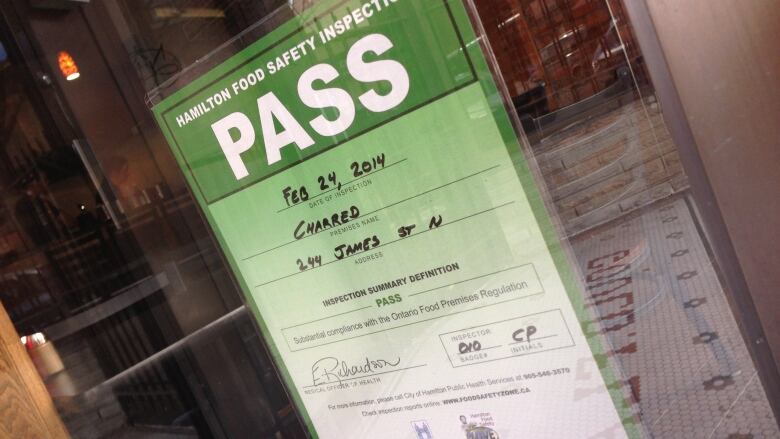New food inspection program rolls out in Hamilton
New three card system replaces old pass or fail system

The next time you walk into a Hamilton restaurant, have a look at the front door or window. Theres a new, more colourful food safety inspection disclosure program being rolled out throughout the city this year.
Before 2014, restaurants would receive a green certificate to hang in their window if they passed a health inspection. However, the city had no way of indicating to the public if there were health or cleanliness issues inside short of pulling down that certificate something most customers wouldnt notice.
Now, whenever a public health inspector visits a restaurant for an inspection, it receives one of three certificates, depending on cleanliness and safety: green for a pass, yellow for a conditional pass and red for a fail, which means the business must close. Similar systems have existed in the GTA and Halton regions for years, and Hamilton has been playing catch up.
Food safety by the numbers
- The city performs between 400 to 450 health inspections in restaurants a month
- 231 green pass cards were removed from restaurants in 2012
- 192 green pass cards were removed from restaurants in 2013
- Inspectors have issued 16 yellow cards for critical infractions in January, and three red cards for closures
As part of the new program, the city has launched a website where people can check a restaurants health and safety inspection records.
These measures were taken to create a more effective way of disclosing food safety to the public, says Richard MacDonald, the city food safety manager.
The intent is just to improve food safety and transparency, MacDonald told CBC Hamilton.
High and low risk
The city performs between 400 to 450 health inspections in restaurants a month, broken down between high, medium and low risk establishments.
High risk applies to any restaurant that is cooking from raw that would handle things like raw meat. Those establishments are inspected three times a year.
Medium risk refers to any place that uses prepackaged frozen foods. Theyre inspected twice a year. Low risk usually applies to places like convenience stores, which are inspected once a year.
However, if a health inspector finds a critical health infraction, he can now apply a yellow conditional pass to hang in the window, then return within 48 hours to re-inspect, MacDonald said. We do have the option to increase inspections, he said.
The citys new colour coded system was first implemented on Jan. 1, and since it was ushered in, inspectors have issued 16 yellow cards for critical infractions and three red cards for closures which is about average in the city, MacDonald says.
The three red cards were handed out to companies that had no hot water, because of frozen or burst pipes during Januarys intense cold.
In 2012, 231 green pass cards were removed from restaurants, compared to 192 in 2013.
MacDonald says that according to inspector feedback, restaurant operators are heeding the new system. Theyre paying attention, he said. They dont want to be wearing their reputation on the front door, he said.
Avoiding yellow
But not all restaurant owners think the new system is totally rosy, says Bruce Kale, the general manager of the George Hamilton restaurant and bar in central Hamilton. It can be a little damaging if you get yellows and people throw up red flags in their minds, Kale said. It can be a bit harsh for the restaurant.
According to the city, the George Hamilton was convicted for violations of food premises regulations on Jan. 24, 2014 for operating its premises in a way that was adversely affecting sanitary condition.
Kale told CBC Hamilton that the new rules will likely make management in most restaurants ensure that theyre taking the proper steps to not end up with a yellow or red in their window. The old system wasnt providing much information to the public, he says.
Somebody could walk in and not even realize there was an issue, he said. Im not trained to look around and make sure theres a green certificate up there.












_(720p).jpg)


 OFFICIAL HD MUSIC VIDEO.jpg)
.jpg)



























































































